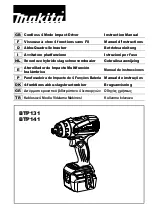
PDSSAP 20-Li A1
■
46
│
GB
│
MT
1. Work area safety
a)
Keep work area clean and well lit.
Cluttered
or dark areas invite accidents.
b)
Do not operate power tools in explosive atmo-
spheres, such as in the presence of flammable
liquids, gases or dust.
Power tools create sparks,
which may ignite the dust or fumes.
c)
Keep children and bystanders away while
operating a power tool.
Distractions can cause
you to lose control.
2. Electrical safety
a)
Power tool plugs must match the outlet. Never
modify the plug in any way.
Do not use any adapter plugs with earthed
(grounded) power tools.
Unmodified plugs
and matching outlets will reduce risk of electric
shock.
b)
Avoid body contact with earthed or grounded
surfaces, such as pipes, radiators, ranges and
refrigerators.
There is an increased risk of elec-
tric shock if your body is earthed or grounded.
c)
Do not expose power tools to rain or wet
conditions.
Water entering a power tool will
increase the risk of electric shock.
d)
Do not abuse the cord. Never use the cord
for carrying, pulling or unplugging the power
tool. Keep cord away from heat, oil, sharp
edges or moving parts.
Damaged or entangled
cords increase the risk of electric shock.
e)
When operating a power tool outdoors, use
an extension cord suitable for outdoor use.
Use of a cord suitable for outdoor use reduces
the risk of electric shock.
f)
If operating a power tool in a damp location
is unavoidable, use a residual current device
(RCD) protected supply.
Use of an RCD
reduces the risk of electric shock.
3. Personal safety
a)
Stay alert, watch what you are doing and use
common sense when operating a power tool.
Do not use a power tool while you are tired or
under the influence of drugs, alcohol or medi-
cation.
A moment of inattention while operating
power tools may result in serious personal injury.
b)
Use personal protective equipment. Always
wear eye protection.
Protective equipment such
as a dust mask, non-skid safety shoes, hard hat or
hearing protection used for appropriate condi-
tions will reduce personal injuries.
c)
Prevent unintentional starting. Ensure the
power tool is switched off before connecting
to power source and/or battery pack, picking
up or carrying the tool.
Carrying power tools
with your finger on the switch or energising
power tools that have the switch on invites acci-
dents.
d)
Remove any adjusting key or wrench before
turning the power tool on.
A wrench or a key
left attached to a rotating part of the power tool
may result in personal injury.
e)
Do not overreach. Keep proper footing and
balance at all times.
This enables better control
of the power tool in unexpected situations.
f)
Dress properly. Do not wear loose clothing or
jewellery. Keep your hair and clothing away
from moving parts.
Loose clothes, jewellery or
long hair can be caught in moving parts.
g)
If devices are provided for the connection of
dust extraction and collection facilities, ensure
these are connected and properly used.
Use
of dust collection can reduce dust-related
hazards.
h)
Do not allow yourself to get lulled into a false
sense of security and do not ignore the safety
rules for power tools, even if you are familiar
with the power tool after repeated use.
A care-
less action can cause severe injury within a frac-
tion of a second.
IB_329780_PDSSAP20-LiA1_LB5.indb 46
07.08.20 13:57
Содержание PDSSAP 20-Li A1
Страница 3: ...A 1a...
Страница 18: ...PDSSAP 20 Li A1 14 ES...
Страница 32: ...PDSSAP 20 Li A1 28 IT MT...
Страница 46: ...PDSSAP 20 Li A1 42 PT...
Страница 60: ...PDSSAP 20 Li A1 56 GB MT...
Страница 74: ...PDSSAP 20 Li A1 70 DE AT CH...
















































